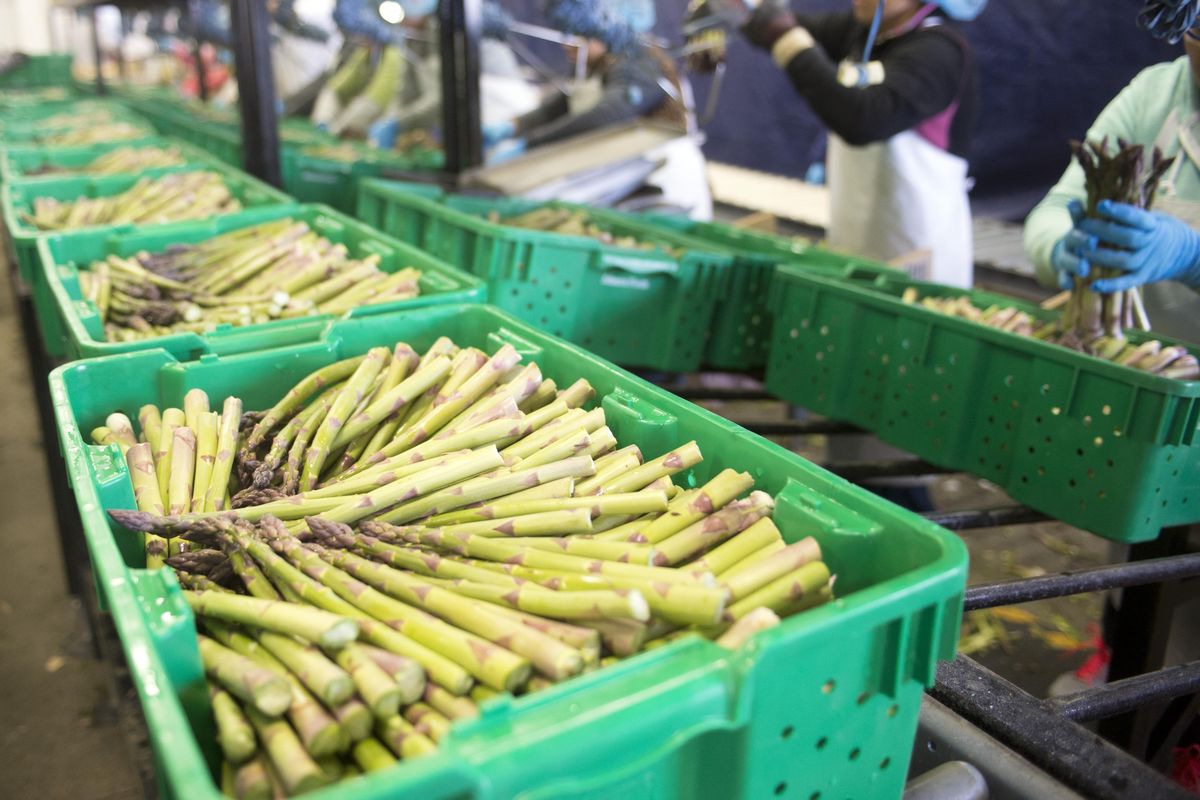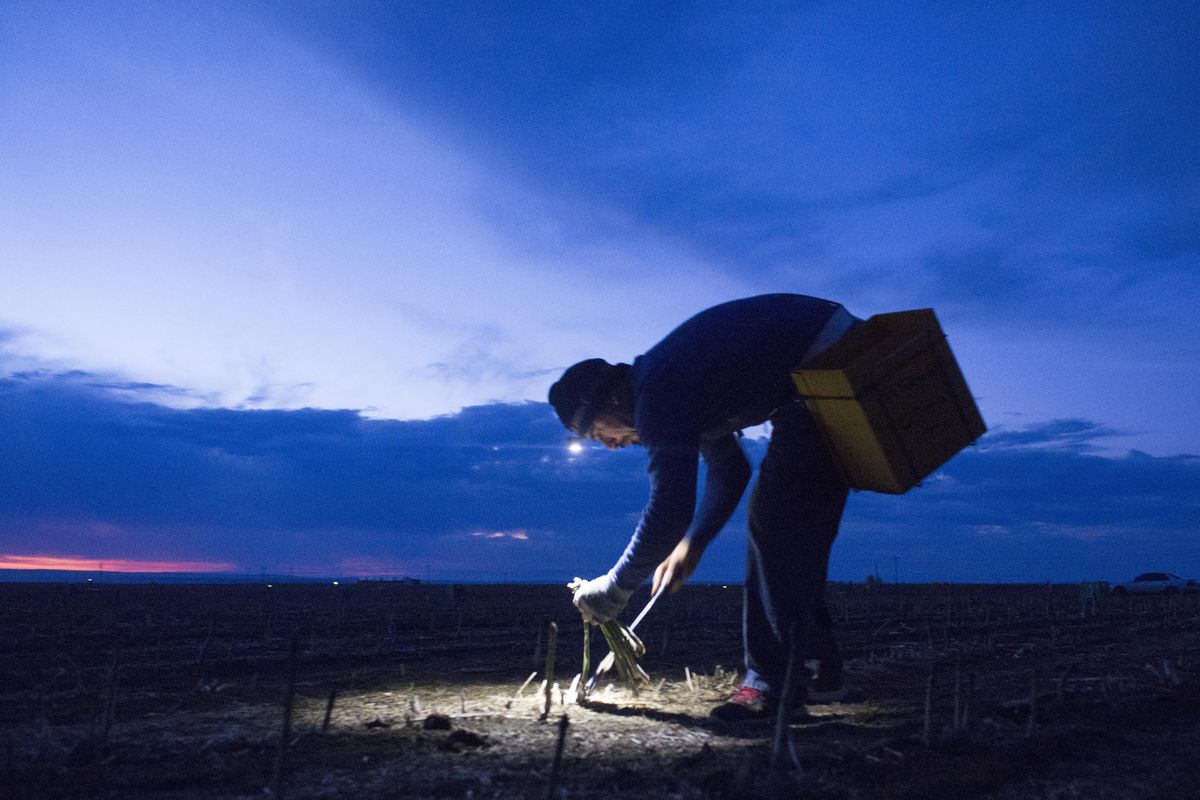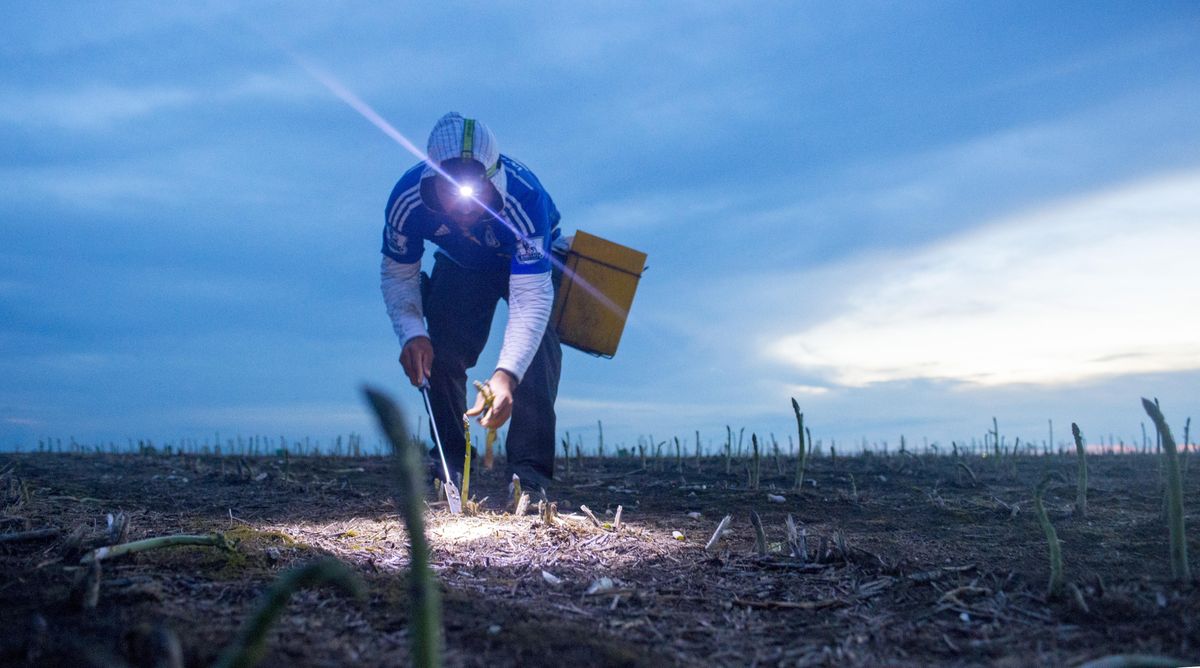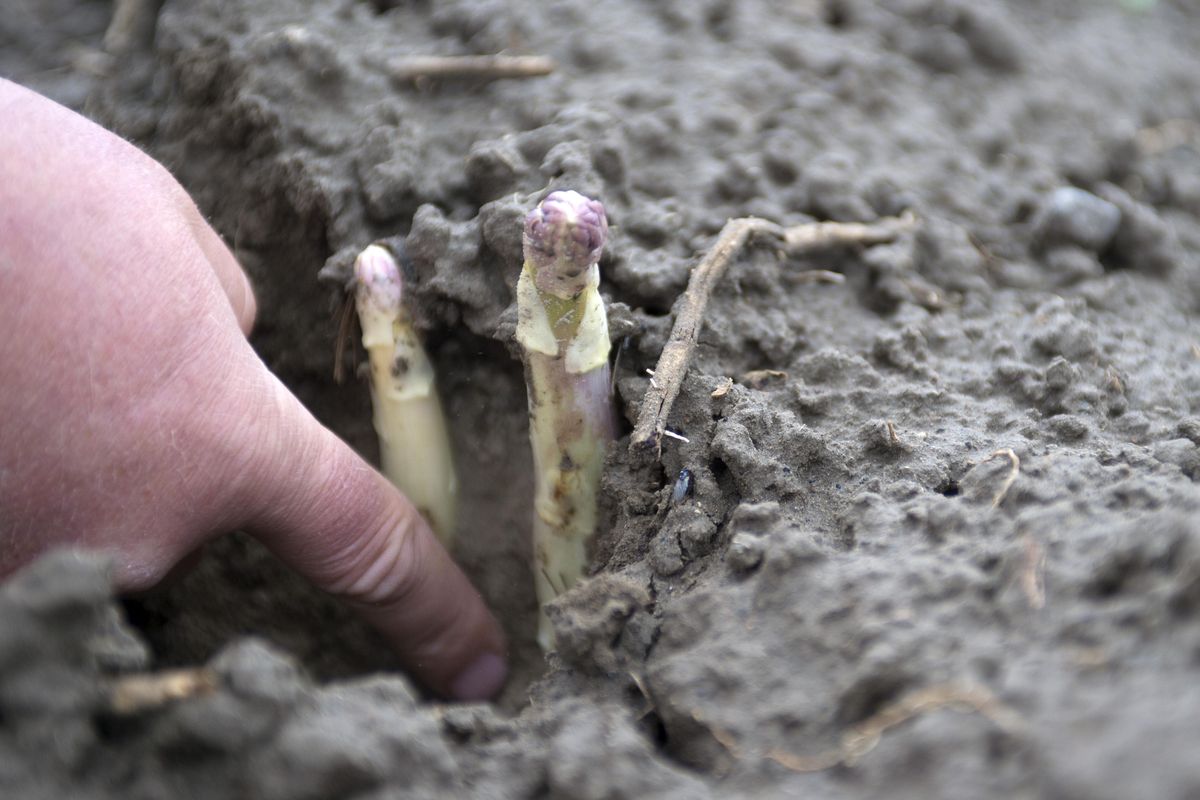
Washington asparagus faces dual threat from labor costs and cheap imports
PASCO – You might have to strain a bit, maybe stand on the back of a flatbed truck to see them, but from the Wal-Mart parking lot, you can see some of the country’s best asparagus fields.
So it particularly irked Gary Larsen last year when – at the height of Washington’s asparagus season, with harvest happening in the shadow of the retail giant – he spotted spears from Mexico in the Pasco Wal-Mart’s produce aisle.
Earlier this month, Larsen, chairman of the Washington Asparagus Commission, learned the retailer would also be buying more asparagus from Michigan, where the minimum wage is $8.90 and the cost of asparagus is less.
Not all retailers are willing to pay a premium for Washington asparagus, which costs more than the foreign-grown spears or even spears grown in California and Michigan, America’s other two top asparagus-growing states. Labor costs here drive up the price.
“Your minimum wage has gone up. Your taxes on payroll have gone up,” Larsen said. “It’s expensive.”
Asparagus is one of the most labor-intensive crops to harvest and handle. Each individual spear is cut by hand. The spears are then hand-sorted. They’re hand-packed, too.
“That’s the main problem: labor,” said Ron Granholm, a third-generation farmer who grows some 125 acres of asparagus near Harrah in the Yakima Valley.
His concerns are twofold, and they mirror those of other farmers in the industry. There’s the cost of labor, and there’s the shrinking – and undocumented – labor force.
Based on a national study, Mike Gempler, executive director of the Washington Growers League, estimates about half of Washington farm workers are undocumented. And for some certain crops, including asparagus, the numbers could be even higher.
Asparagus workers “are very exposed,” Gempler said. “The whole industry is very exposed.”
Comprehensive immigration reform could help stabilize the workforce. Workable government policy providing for legal entry for laborers willing to do some of the hardest farm work, such as cutting asparagus, is needed, he said.
“Trump has made some noises about being open to that,” Gempler said. However, the new administration also seems to “have a very negative stance on most immigration issues.”
“We’re very concerned about them creating an enforcement-only policy,” Gempler said.

Washington state’s dependence on foreign farm labor can be traced to the federal Bracero program, which brought hundreds of thousands of workers from Mexico to harvest crops from 1942 through the early 1960s. Two dozen years later, Congress passed immigration legislation that included amnesty for undocumented workers currently living in the country. Many made the U.S. their permanent home.
In the three decades since, the flow of Mexican migrants has ebbed and farm owners are experiencing the consequences.
“We do not have an adequate supply of labor that is legal to harvest our crop,” said Alan Schreiber, director of the Washington Asparagus Commission. “We cannot get people that are here legally to do this work. The pool of workers the industry has access to is finite and contracting. The situation is not going to end until we have immigration reform.”
H2A visas are temporary work permits for foreign agricultural workers with offers for seasonal farm work in the U.S.
But, Schreiber said, the H2A program isn’t a good fit for asparagus growers. The season is too short; the costs, too high to come out ahead.
“The H2A doesn’t work for us,” Schreiber said. “Asparagus only lasts 70 days. You can’t make it work for 70 days. Over 90 percent of all H2A workers are in tree fruit. You’ve got to spread out your costs, and they can generally work over nine months.”
Gempler favors revamping the H2A program as well as establishing a “blue card” visa to allow guest workers to toil at different farms for a period of up to three years. They wouldn’t be contracted to one particular farm, which would give workers and farmers more flexibility – something that’s needed for crops with short seasons, such as asparagus.
On top of that, “we also need to legalize the existing workforce, the people we have here,” Gempler said. “It gives people who have been working here an opportunity to stay. People age out of jobs. We really need a bridge to the future.”

Labor is an issue across all crops. Minimum wage is going up. But, in the asparagus industry, where so much of the work is done by hand versus automation, “we’re more exposed to the high cost of labor,” Schreiber said. “We are very, very vulnerable.”
It’s manageable if production levels are high enough, Schreiber said. One strategy is to reduce dependence on labor, but harvesting is hard work.
“I think the hardest part is bending over all the time,” Granholm said. “There’s a lot of skill to it.”
Granholm, 58, cultivates fields at the end of a road named for his family. His grandfather started farming here in 1905. His father farmed alfalfa, peppermint, spearmint and sugar beets, among other crops. Today, he farms with his daughter, Erica, 31, the fourth generation to farm. They grow grass, carrot and red clover seed along with asparagus, which makes up about 15 percent of their total crops.
Grandholm put in crowns because “there was nothing else that looked promising to pay the bills,” he said.
He planted asparagus in 1990, the same year the Andean Trade Preference Act was signed. It took effect a year later. Canneries closed and moved to Peru.
“All of a sudden, we had all of these growers trying to find a home,” he said. “It was a rat race.”
Granholm survived, but “we’re looking for another crop now.”
Farmworkers, his daughter said, “keep wanting more every year, and we’re not getting paid more.”
The Granholms bring their spears to Johnson Foods in Sunnyside for packing and processing. Gary Johnson, 49, is president of the family-owned company founded in 1949.

“I think people are nervous about planting asparagus, because it’s expensive to harvest and labor is in tight supply,” Johnson said. “There’s fewer farmers. But there’s better quality, higher yields.
“With labor costs ever-increasing in Washington, that doesn’t help the situation.
“There’s going to have to be some change. We’re going to have to rely more on machines,” Johnson added. “We’re going to have to eliminate labor, eliminate people. We just can’t compete with the prices out of Mexico or Peru.”
After the industry collapse and a new focus on fresh asparagus as well as new techniques and varieties, Larsen said, “We’re clawing our way back.
“We’re trying to fight back. We’re trying to make people aware Washington has an asparagus season. We’re here for a month, two months. And then we’re out.”
As the sun begins to peek above the horizon, asparagus cutter Juan Chavez works by headlamp in the field of farmer Gary Larsen in the Columbia Valley north of Pasco on Friday, May 5, 2017. Coming off a hot day Thursday, Chavez is happy that there are a lot of spears to cut. "I'm making money today," he said. (Jesse Tinsley / The Spokesman-Review)Buy a print of this photo
Larsen’s fields are about 15 miles northeast of the Wal-Mart in Pasco.
“I’ve had fresh asparagus from Peru,” he said. “I’ve had fresh asparagus from Mexico.
“I think the stuff from Washington is sweeter.”
He prefers it over Michigan and California, too.
He employs about 150 cutters during asparagus season and grows more than 300 acres on a farm his father started in the 1960s.
“My pledge this year was to have asparagus every day of harvest,” he said. “So far, I’ve done it.”
The NAFTA effect
Washington’s asparagus industry had to reinvent itself once after a subsidized Peruvian industry took over canned production. But now, Mexico looks to be the biggest threat.
Over the past decade, Mexico has nearly tripled its asparagus production, making it the third-largest producer in the world after China and Peru. In 2016, Mexico grew 208,435 metric tons of asparagus, according to the Mexican Secretary of Agriculture, Livestock, Rural Development, Fish and Food (SAGARPA, in Spanish). And while Peru grows more fresh product, much of that is exported to Europe.
The North American Free Trade Agreement opened the door for Mexican asparagus to come to the U.S., but it’s not the sole reason growers fear Mexican competition.
Unlike Peruvian asparagus, Mexican asparagus isn’t available year-round. Production peaks from December to April, when about 70 percent of the crop is harvested, SAGARPA said.
But the industry is growing and expanding into new states, and with that comes more availability.
Mexican asparagus tends to be a thinner, pea-green spear, while Washington varieties are more purple and thicker.



























































